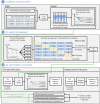AI algorithm for personalized resource allocation and treatment of hemorrhage casualties
- PMID: 38332989
- PMCID: PMC10851938
- DOI: 10.3389/fphys.2024.1327948
AI algorithm for personalized resource allocation and treatment of hemorrhage casualties
Abstract
A deep neural network-based artificial intelligence (AI) model was assessed for its utility in predicting vital signs of hemorrhage patients and optimizing the management of fluid resuscitation in mass casualties. With the use of a cardio-respiratory computational model to generate synthetic data of hemorrhage casualties, an application was created where a limited data stream (the initial 10 min of vital-sign monitoring) could be used to predict the outcomes of different fluid resuscitation allocations 60 min into the future. The predicted outcomes were then used to select the optimal resuscitation allocation for various simulated mass-casualty scenarios. This allowed the assessment of the potential benefits of using an allocation method based on personalized predictions of future vital signs versus a static population-based method that only uses currently available vital-sign information. The theoretical benefits of this approach included up to 46% additional casualties restored to healthy vital signs and a 119% increase in fluid-utilization efficiency. Although the study is not immune from limitations associated with synthetic data under specific assumptions, the work demonstrated the potential for incorporating neural network-based AI technologies in hemorrhage detection and treatment. The simulated injury and treatment scenarios used delineated possible benefits and opportunities available for using AI in pre-hospital trauma care. The greatest benefit of this technology lies in its ability to provide personalized interventions that optimize clinical outcomes under resource-limited conditions, such as in civilian or military mass-casualty events, involving moderate and severe hemorrhage.
Keywords: artificial intelligence; fluid resuscitation; hemorrhage; resource utilization; trauma.
Copyright © 2024 Jin, Frock, Nagaraja, Wallqvist and Reifman.
Conflict of interest statement
The authors declare that the research was conducted in the absence of any commercial or financial relationships that could be construed as a potential conflict of interest. The author(s) declared that they were an editorial board member of Frontiers, at the time of submission. This had no impact on the peer review process and the final decision.
Figures










Similar articles
-
Physiological and medical monitoring for en route care of combat casualties.J Trauma. 2008 Apr;64(4 Suppl):S342-53. doi: 10.1097/TA.0b013e31816c82f4. J Trauma. 2008. PMID: 18385586 Review.
-
APPRAISE-HRI: AN ARTIFICIAL INTELLIGENCE ALGORITHM FOR TRIAGE OF HEMORRHAGE CASUALTIES.Shock. 2023 Aug 1;60(2):199-205. doi: 10.1097/SHK.0000000000002166. Epub 2023 Jun 19. Shock. 2023. PMID: 37335312 Free PMC article.
-
Advanced medical monitoring for the battlefield: A review on clinical applicability of compensatory reserve measurements for early and accurate hemorrhage detection.J Trauma Acute Care Surg. 2022 Aug 1;93(2S Suppl 1):S147-S154. doi: 10.1097/TA.0000000000003595. Epub 2022 Mar 8. J Trauma Acute Care Surg. 2022. PMID: 35271546 Review.
-
The impact of prehospital administration of freeze-dried plasma on casualty outcome.J Trauma Acute Care Surg. 2019 Jan;86(1):108-115. doi: 10.1097/TA.0000000000002094. J Trauma Acute Care Surg. 2019. PMID: 30358770
-
Prehospital Resuscitation Performed on Hypotensive Trauma Patients in Afghanistan: The Prehospital Trauma Registry Experience.Mil Med. 2019 May 1;184(5-6):e154-e157. doi: 10.1093/milmed/usy252. Mil Med. 2019. PMID: 30295843
Cited by
-
A model to simulate human cardio-respiratory responses to different fluid resuscitation treatments after hemorrhagic injury.Front Physiol. 2025 Jul 1;16:1613874. doi: 10.3389/fphys.2025.1613874. eCollection 2025. Front Physiol. 2025. PMID: 40666119 Free PMC article.
-
Navigating Hemorrhagic Shock: Biomarkers, Therapies, and Challenges in Clinical Care.Biomedicines. 2024 Dec 17;12(12):2864. doi: 10.3390/biomedicines12122864. Biomedicines. 2024. PMID: 39767770 Free PMC article. Review.
-
Neutrophil-to-lymphocyte ratio and systemic inflammation response index as biomarkers for the clinical outcomes of intracerebral hemorrhagic stroke patients: a prospective cohort study.Front Neurol. 2025 Jul 22;16:1616128. doi: 10.3389/fneur.2025.1616128. eCollection 2025. Front Neurol. 2025. PMID: 40765613 Free PMC article.
-
Opportunities for Artificial Intelligence in Operational Medicine: Lessons from the United States Military.Bioengineering (Basel). 2025 May 14;12(5):519. doi: 10.3390/bioengineering12050519. Bioengineering (Basel). 2025. PMID: 40428137 Free PMC article. Review.
References
-
- Alsalti M., Tivay A., Jin X., Kramer G. C., Hahn J.-O. (2022). Design and in silico evaluation of a closed-loop hemorrhage resuscitation algorithm with blood pressure as controlled variable. J. Dyn. Syst. Meas. Control. 144, 021001. 10.1115/1.4052312 - DOI
-
- Bray A., Webb J. B., Enquobahrie A., Vicory J., Heneghan J., Hubal R., et al. (2019). Pulse physiology engine: an open-source software platform for computational modeling of human medical simulation. SN Comp. Clin. Med. 1, 362–377. 10.1007/s42399-019-00053-w - DOI
-
- Burges C. J. (1998). A tutorial on support vector machines for pattern recognition. Data Min. Knowl. Discov. 2, 121–167. 10.1023/A:1009715923555 - DOI
LinkOut - more resources
Full Text Sources

